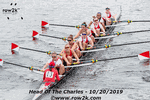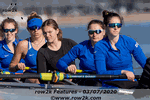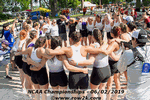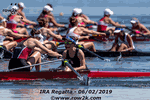Crew Selection Part 2 - Seat Racing

Following the cancellation of the 2020 spring racing season, row2k solicited the collegiate coaching community to engage in a variety of high-level topics within the profession. We submitted over sixty questions across a dozen topics and thank the coaches and staffs that found time to contribute their thoughts during this stressful time.
This week we focus on the topic of Crew Selection with the following question:
HOW MUCH STOCK DO YOU PUT INTO SEAT RACING RESULTS RELATIVE TO OTHER COMPARISON METHODS?
DAN ROOCK – DARTMOUTH LIGHTWEIGHT MEN
A lot, although winning a singular seat race does not make one a rowing god for life, or even for the next piece. Proper selection is a matter of observation over time using many methods and criteria, with what happens in a shell moving at speed over the racing distance the prime determinant. I caution against pre-conceptions, and trust what is seen on the water.
NICK JOHNSON – BARRY WOMEN
We are a pretty small squad and our NCAA boats are the V8 and V4, so we just need to select a dozen rowers. By February or March it’s usually pretty clear who those dozen are, but if we are trying to sort out the bottom end of the V8 and top end of the V4, or if we actually have a 13th and 14th kid fighting for the V4, we might do some time trials in various lineups to look for patterns and consistency in results. If that doesn’t give us clear answers, we will do some side-by-side seat racing, but we are pretty particular about how that works, because there are so many factors that can skew results.

ALICEA STRODEL – MINNESOTA WOMEN
We always start with physiology, but the truth always reveals itself. I pay attention to mixed line-ups; what boats are over-performing or underperforming? Who am I underestimating or overestimating? Trends start to develop, and your best rowers emerge.
CAMPBELL WOODS – MARIST MEN
Seat racing is really great, fun, and important for the athletes to do; and really NOT great at creating long term boats. When I was in college, I had a coach that I felt ignored seat race results so when I first started coaching, I promised myself that every single seat in my boats would be won in a seat race. I was wrong. I tried everything; from one-on-one races, to really complex matrices where the athletes never knew who they were racing, and every season I would end up with an anchor in my boat who I knew didn’t belong there, but who had somehow miraculously won all their seat races.
The problem with seat racing is the sheer number of different variables that can affect the outcomes. You can work diligently to try and limit these factors, but they will still be there and ultimately no single seat race outcome can be taken seriously as an overall performance indicator.
I have learned to do a few things:
A) use erg scores to set an initial selection for each boat so that the pool you are picking from at least contains only the athletes that belong in that crew (you can use both raw and weight adjusted times here, I typically look among my top 12-14 athletes for the V8)
B) If you, as the coach, have a legitimate rowing related reason to NOT want a specific athlete then you are ALWAYS right (if you know who the anchor is then don’t give them the race!)
C) Seat Racing is a great way to select athletes between 2-3 guys for a seat when you don’t have a strong preference for one over the other. This happens often in many different levels of a program.
Long story short, seat racing as a means of creating competition, getting a great workout and learning to mix it up with a variety of athletes is fantastic. Seat racing as a primary form of boat selection is bad news.
BART THOMPSON – ADRIAN
I don’t put as much emphasis on a singular seat race as I would have put into it 2-3 years ago. One thing I’ve learned in the past few years is that seat racing isn’t as hard-and-fast accurate as we as coaches would like because the athletes aren’t as repeatable as we would like. I’ve done seat races where I’ve switched the same two rowers over the gunwales 4 times in a row and each rower won 2 of the 4 pieces by a margin that, on its own, most coaches would consider as significant. I’ve also had situations where the same two crews race 4-5 times in a row, side-by-side, and the results vary significantly between pieces, despite the crews remaining totally intact.
GABE WINKLER – OREGON STATE MEN
We have a river here and it’s extremely tricky to know the speed of the boats because of the current. I go on trends more than exact, “this guy is better than the other on one piece.” We still do a lot of switches, though. We do switches for every practice, for every piece. Doing legs only by pairs? There still may be switches.
I think this is the best method to keep guys focused and intent on what they are doing. You can use the erg score and other data to comprise the boats but if one guy consistently moves the boat faster than another guy, even though he is 15 seconds slower on the erg, you have to go with what you see on the water.
JENN LANGZETTEL – DUQUESNE WOMEN
Initially in a season we put quite a bit into seat racing in fours, but as the season progresses, we are looking at how a boat is executing as a whole, and where adjustments can be made to improve the movement regardless of the seat race results.

BILL ZACK – SAN DIEGO STATE WOMEN
I’m not big on seat racing. There are so many variables above and beyond the people who get switched. Margins between two crews doing multiple pieces with no switches change all the time, so how valid can seat racing be? In a high school or college setting, seat racing results might vary based on who had to stay up late the night before to finish an assignment. I believe in trying out different lineups throughout the course of the year and using the entirety of available data to set boats.
SANDRA CHU – WILLIAM SMITH WOMEN
I don’t like to put all the selection into one seat racing session. We look at a lot of different diagnostics and track line-ups changes from day to day. We use this to build our seat racing matrix and then take it from there. I like consistency, so a student who always makes a line-up win is an easier selection choice than the student who just wins her switch. I do believe in reliable data, so I no longer race point to point. We use GPS devices for every piece so that my eye, turns in the course, poor steering or wonky alignments don’t give me biased results.
KEMP SAVAGE – EASTERN MICHIGAN WOMEN
I like to think of seat racing like a job interview, your resume of erg tests and practice performance gets you a seat race, but if you don't win a seat race you don't get a seat.
MEGAN COOKE CARCAGNO – DUKE WOMEN
I think seat racing helps you see if someone who should be moving the boat simply isn’t or someone who shouldn’t be in the boat, on paper, should.
TODD KENNETT – CORNELL HEAVYWEIGHT MEN
Seat racing is a great tool, but it is only a tool. You can be fooled by some results, so you have to watch carefully. You also have to make sure you are running fair races, and are your athletes all really ready having a relatively good day? One is sick, one is having the best week of their lives, but what happens the next week? Also, direct side-by-side seat racing is very different than time trial seat racing. I like to mix them up depending on the situation and often to cross check a result.
LUKE AGNINI – GEORGETOWN HEAVEYWEIGHT MEN
I look more at the body of work over the year. Guys will often ask when they will get their seat race. My answer is always the same, you are getting evaluated every day. Eventually trends show for guys and small lineup variations from day to day will show you who is typically in a losing or winning boat. Or, who has the ability to go into a slow lineup and make a positive impact.

Preferably, throughout the year, you can identify who the best rowers are and have some of the critical seats of the boat figured out. Once you have the majority of a lineup figured out, seat racing in 8’s for a particular seat is the preferred method in the spring. We do a lot of swapping around throughout the year, in small boats and big, but there are always so many factors, the rowers, the coxswains, the conditions. Plus, these guys are student athletes. You don’t want to switch a guy who is spread so thin because of a tough academic week or battling health issues you may not know about.
Also, each body of water can be so different. I think any coach really has to get used to their body of water and how they can use it for training and selection. Not many programs have an ideal setting. Single switches can easily get skewed, especially in April when the entire east coast is white-capped every day.
BRIAN DAWE – TUFTS
Very little actually. We don’t have the number of sessions available that it would take to get statistically reliable results. College rowers vary too much from day to day for this to work correctly. We do a lot of rowing in singles and quads in the fall and make some judgements on how each of those systems look for different individuals. Results of test pieces over different distances make things obvious to everyone involved.
If you enjoy and rely on row2k, we need your help to be able to keep doing all this. Though row2k sometimes looks like a big, outside-funded operation, it mainly runs on enthusiasm and grit. Help us keep it coming, thank you! Learn more.
Comments | Log in to comment |
There are no Comments yet
| |
- Bont Rowing
- Calm Waters Rowing
- Concept 2
- Craftsbury Sculling
- The Crew Classic
- CrewLAB
- Croker
- Durham Boat Co.
- Empacher
- Faster Masters
- Filippi
- Fluidesign
- h2row.net
- HUDSON
- Live2Row Studios
- Nielsen-Kellerman
- Oak Ridge RA
- Peinert Boat Works
- Pocock Racing Shells
- Race1 USA
- RowKraft
- Rubini Jewelers
- Vespoli USA
- WinTech Racing
- Bont Rowing
- Calm Waters Rowing
- Concept 2
- Craftsbury Sculling
- The Crew Classic
- CrewLAB
- Croker
- Durham Boat Co.
- Empacher
- Faster Masters
- Filippi
- Fluidesign
- h2row.net
- HUDSON
- Live2Row Studios
- Nielsen-Kellerman
- Oak Ridge RA
- Peinert Boat Works
- Pocock Racing Shells
- Race1 USA
- RowKraft
- Rubini Jewelers
- Vespoli USA
- WinTech Racing




















